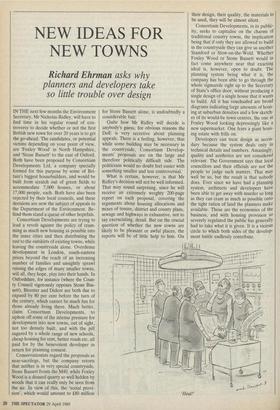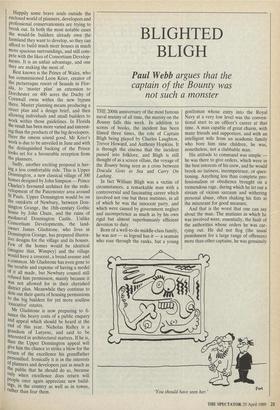NEW IDEAS FOR NEW TOWNS
Richard Ehrman asks why planners and developers take so little trouble over design
IN THE next few months the Environment Secretary, Mr Nicholas Ridley, will have to find time in his regular round of con- troversy to decide whether or not the first British new town for over 20 years is to get the go-ahead. The candidates, or potential victims depending on your point of view, are 'Foxley Wood' in North Hampshire, and 'Stone Bassett' to the east of Oxford. Both have been proposed by Consortium Developments Ltd, a company specially formed for this purpose by some of Bri- tain's biggest housebuilders, and would be built from scratch out of green fields to accommodate 7,000 houses, or about 17,000 people, each. Both have also been rejected by their local councils, and these decisions are now the subject of appeals to the Department of the Environment. Be- hind them stand a queue of other hopefuls.
Consortium Developments are trying to lead a revolt against the policy of cram- ming as much new housing as possible into the inner cities and then distributing the rest to the outskirts of existing towns, while leaving the countryside alone. Overdense development in London, south-eastern prices beyond the reach of an increasing number of families and unsightly sprawl ruining the edges of many smaller towns, will all, they hope, play into their hands. In Oxfordshire, for instance (where the Coun- ty Council vigorously opposes Stone Bas- sett), Bicester and Didcot are both due to expand by 80 per cent before the turn of the century, which cannot be much fun for those already living there. Much better, claim Consortium Developments, to siphon off some of the intense pressure for development into new towns, out of sight, not too densely built, and with the pill sugared by a whole range of new schools, cheap housing for rent, better roads etc, all paid for by the benevolent developer in return for planning consent.
Conservationists regard the proposals as near-sacrilege, but the company retorts that neither is in very special countryside. Stone Bassett fronts the M40, while Foxley Wood is a disused quarry so well hidden by woods that it can really only be seen from the air. In view of this, the 'social provi- sion', which would amount to £80 million for Stone Bassett alone, is undoubtedly a considerable bait.
Quite how Mr Ridley will decide is anybody's guess; for obvious reasons the DoE is very secretive about planning appeals. There is a feeling, however, that while some building may be necessary in the countryside, Consortium Develop- ments' proposals are on the large and therefore politically difficult side. The politicians would no doubt feel easier with something smaller and less controversial.
What is certain, however, is that Mr Ridley's decision will not be well informed. That may sound surprising, since he will receive an extremely weighty 200-page report on each proposal, covering the arguments about housing allocations and mixes of tenure, district and county plans, sewage and highways in exhaustive, not to say excruciating, detail. But on the crucial question of whether the new towns are likely to be pleasant or awful places, the reports will be of little help to him. On their design, their quality, the materials to be used, they will be almost silent.
Consortium Developments, in its public- ity, seeks to capitalise on the charms of traditional country towns, the implication being that if only they are allowed to build in the countryside they can give us another Stamford or Stow-on-the-Wold. Whether Foxley Wood or Stone Bassett would in fact come anywhere near that exacting ideal is, however, open to doubt. The planning system being what it is, the company has been able to go through the whole rigmarole right up to the Secretary of State's office door, without producing a single design of a single house that it wants to build. All it has vouchsafed are broad diagrams indicating large amounts of hous- ing at suburban densities and a few sketch- es of its would-be town centres, the one at Foxley Wood looking depressingly like a new supermarket. One fears a giant hous- ing estate with frills on.
Developers can treat design as secon- dary because the system deals only in technical details and numbers. Amazingly, quality and aesthetics are not considered relevant. The Government says that local councillors and their officials are not the people to judge such matters. That may well be so, but the result is that nobody does. Ever since we have had a planning system, architects and developers have been able to get away with murder so long as they can cram as much as possible onto the tight ration of land the planners make available. Those are the economics of the business, and with housing provision so severely regulated the public has generally had to take what it is given. It is a vicious circle to which both sides of the develop- ment battle endlessly contribute.
'Heal!'
Happily some brave souls outside the enclosed world of planners, developers and professional conservationists are trying to break out. In both the most notable cases the would-be builders already own he farmland they want to develop, so they can afford to build much nicer houses in much more spacious surroundings, and still com- pete with the likes of Consortium Develop- ments. It is an unfair advantage, and one they are making the most of.
Best known is the Prince of Wales, who has commissioned Leon Krier, creator of the picturesque resort of Seaside in Flor- ida, to 'master plan' an extension to Dorchester on 400 acres the Duchy of Cornwall owns within the new bypass there. Master planning means producing a street plan and a design brief, and then allowing individuals and small builders to work within those guidelines. In Florida the result has been more varied and interest- ing than the products of the big developers. Here the omens sound good. Mr Krier's work is due to be unveiled in June and with the distinguished backing of the Prince looks set for a favourable reception from the planners.
Sadly, another exciting proposal is hav- ing a less comfortable ride. This is Upper Donnington, a new classical village of 300 homes designed by John Simpson — Prince Charles's favoured architect for the rede- velopment of the Paternoster area around St PauIs. Upper Donnington would be on the outskirts of Newbury, between Don- nington Grange, the 18th-century Gothic house by John Chute, and the ruins of mediaeval Donnington Castle. Unlike Consortium Developments, the land- owner James Gladstone, who lives in Donnington Grange, has prepared illustra- tive designs for the village and its houses. Few of the homes would be identical (imagine that, Wimpey) and the village would have a crescent, a broad avenue and a common. Mr Gladstone has even gone to the trouble and expense of having a model of it all made, but Newbury council still refused him permission, mainly because it was not allowed for in their cherished district plan. Meanwhile they continue to dole out their quota of housing permissions to the big builders for yet more soulless executive' estates.
Mr Gladstone is now preparing to fi- nance the heavy costs of a public enquiry and appeal which should be heard at the end of this year. Nicholas Ridley is a grandson of Lutyens, and said to be interested in architectural matters. If he is, then the Upper Donnington appeal will give him the chance to strike a blow for the return of the excellence his grandfather Personified. Ironically it is in the interests of planners and developers just as much as the public that he should do so, because Only when excellence does return will people once again appreciate new build- ings, in the country as well as in towns, rather than fear them.



















































 Previous page
Previous page